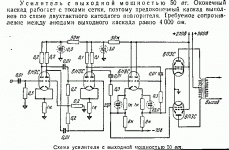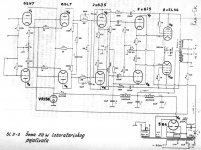The design could be improved by replacing that floating paraphase with an LTP. Although a CCS tail load and a negative rail would have been much harder to implement back in 1955 than it is today. Should have also done something about ditching one of the RC couplings, and adding bias adjust for the finals. Otherwise, pretty much how I designed an 807 amp.
Still, 6L6s without any NFB sound pretty nasty in pure pentode mode (been there; done that). Perhaps this thingy was an AM modulator?
Given the Q-Point, he wasn't gettin' no 50W from those 6L6s. The spec sheet says 26.5W, 30 if you allow for a bit of Class AB2 operation.
Still, 6L6s without any NFB sound pretty nasty in pure pentode mode (been there; done that). Perhaps this thingy was an AM modulator?
Given the Q-Point, he wasn't gettin' no 50W from those 6L6s. The spec sheet says 26.5W, 30 if you allow for a bit of Class AB2 operation.
Wavebourn said:It is AB2. Why they sound well, because of low relatively stiff screen grid supply. And it uses already -70V.
Take another look at that schemo. It gives Vpp= 360Vdc; Vsgsg= 270Vdc; and Vgk= -25.0Vdc. According to the spec sheet, this is the operating point for Po= 26.5W; THD= 1.8%. It's not a 50W amp. If he's pushing it that far, then it SUX at high outputs. To go Class AB2 with this type requires: Vpp= 600Vdc; Vsgsg= 300Vdc.
Sure, using a regulated, Lo-Z screen source will help considerably the linearity of the finals. However, that does nothing for the tendency of the 6L6 to produce high order harmonics. These sound really nasty, like fingernails on a blackboard nasty. That's why I included both local NFB (10% of plate signal fed back as per O. Schade's recommendation) as well as gNFB when designing for this type.
I still suspect that this is the schemo for an AM plate modulator where linearity wasn't a big concern. Might also make a decent gee-tah amp.
Re: while we are at symmetrical ...
This one looks better.
Zen Mod said:Nestorovic Mioljub
Belgrade 1961.
This one looks better.
Re: Re: while we are at symmetrical ...
certainly ;
Mioljub Nestorovic was a man responsible for Nestorovic Lab .
interesting - BudP (as known here at DiyA ) was his co-worker .
he certainly can say few more things about tricks and tips in Nestorovic Lab .....
Wavebourn said:
This one looks better.
certainly ;
Mioljub Nestorovic was a man responsible for Nestorovic Lab .
interesting - BudP (as known here at DiyA ) was his co-worker .
he certainly can say few more things about tricks and tips in Nestorovic Lab .....
Re: Re: while we are at symmetrical ...
It's nice to see (finally) someone putting the cathode followers on the correct side of the final coupling caps.
Wavebourn said:
This one looks better.
It's nice to see (finally) someone putting the cathode followers on the correct side of the final coupling caps.
No, links are fine.
May be Narod.ru site is too slow?
Try a direct one:
http://www.klausmobile.narod.ru/notebook/nb_04f_photo1.jpg
May be Narod.ru site is too slow?
Try a direct one:
http://www.klausmobile.narod.ru/notebook/nb_04f_photo1.jpg
Re: Re: Re: while we are at symmetrical ...
Yep! and only one RC in feedback loop, almost directly coupled. And triode connected EL34. Really nice!
SY said:
It's nice to see (finally) someone putting the cathode followers on the correct side of the final coupling caps.
Yep! and only one RC in feedback loop, almost directly coupled. And triode connected EL34. Really nice!
- Status
- This old topic is closed. If you want to reopen this topic, contact a moderator using the "Report Post" button.
- Home
- Amplifiers
- Tubes / Valves
- Interesting symmetrical amp from 1955 magazine





